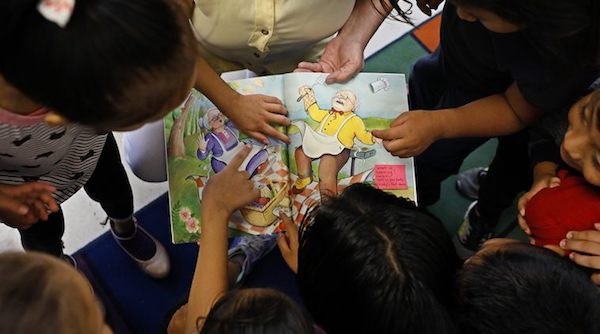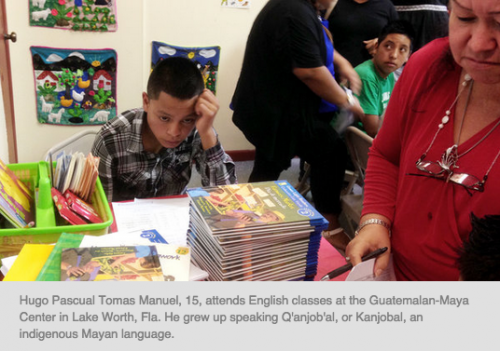Schools scramble to handle thousands of new migrant families, New York Times, July 10, 2019
After Trump announced a nationwide series of planned immigration raids last month, which he later suspended, students began to miss summer school.

Kindergarten teacher Shirley Duffy works with students on reading skills at South Grade Elementary in Lake Worth, Fla., June 25, 2019.
Dayvin Mungia, 7, arrived from El Salvador at South Grade Elementary in South Florida last year with, it seemed, no schooling at all. “He didn’t even recognize the first letter of his name,” said Nicol Sakellarios, his second-grade teacher, as the smiling boy gamely stumbled through his ABCs in summer school not long ago. “Good job, my love,” she said, prodding him on as he faltered again and again.
Laura Martin, 16, who attended school for only three years in Guatemala and speaks an indigenous language, plans to enroll in high school in Florida next month. “Illiterate” and “0” were scrawled on a math worksheet that she tried and failed to complete after she made her way across the border in May.
Migrant children arriving in record numbers are creating challenges for school districts across the country. Many of the newcomers have disjointed or little schooling; their parents, often with limited reading and writing skills themselves and no familiarity with the American education system, are unable to help.
Schools in places like Lake Worth, a city near President Donald Trump’s Mar-a-Lago resort that has become a favorite destination for Guatemalans, are scrambling to hire new staff and add summer sessions to support the newcomers.
Last year, the Palm Beach County school district enrolled 4,555 Guatemalan students in kindergarten through 12th grade, nearly 50% more than two years earlier. Many of the students come from the country’s remote highlands and speak neither Spanish nor English. The number of elementary school students in kindergarten through fifth grade more than doubled to 2,119 in that same period.
Ana Arce-Gonzalez, the principal at South Grade Elementary School, in the heart of Lake Worth’s immigrant enclave, said that in 25 years as an educator she had never experienced anything like it. The school saw its enrollment rise from 820 at the beginning of the last school year to 910 in the spring, pushing it over capacity.
“It speaks to what is happening at the border,” she said.
Under a 1982 Supreme Court decision, all children, regardless of immigration status, are entitled to a K-12 education. With hundreds of thousands of new parents and children crossing the border in recent months, districts across the country are having to transfer teachers to affected schools, expand bilingual training for staff and prepare for students who may be traumatized.
In Florida, Mayan Guatemalans first settled in Indiantown, a village northwest of Palm Beach’s luxurious estates, in the 1980s, to toil in vegetable fields and citrus groves after fleeing a counterinsurgency campaign by the Guatemalan military. Indigenous Guatemalans have arrived here ever since, but spiraling violence and an unforgiving drought that has driven subsistence farmers off their land back home has caused a surge in the last two years.
Lake Worth is a relatively affordable city of 39,000 people and easily accessible to hotels, golf courses, farms and nurseries that hire immigrants. It is also home to immigrants from Haiti and other Central American countries; still, Guatemalans represent the largest group among Hispanics, who now account for more than 40% of the city’s population.
Like other districts serving low-income and immigrant students, Palm Beach County receives an infusion of federal funds to provide extra help for disadvantaged students and those who struggle with English. And while more money would be welcome, it is not the crux of the problem, said Harvey Oaxaca, head of the district’s multicultural education programs.
The district identified 2,000 students in the seventh to 11th grades for remedial summer school English classes. Only half have registered. Many are tending to younger siblings or working to help their families make ends meet.
Lake Worth High School offers evening tutorials and other programs. But district officials said many students choose instead to work — either to send money home, to pay off debts to migrant smugglers or to support themselves in the United States …

